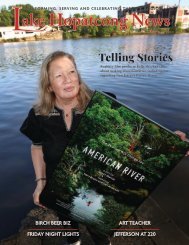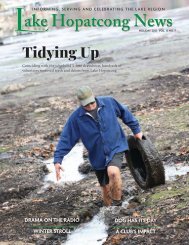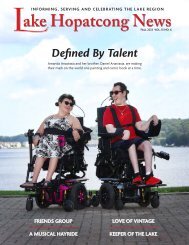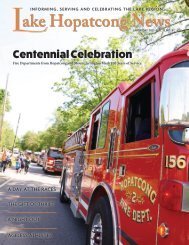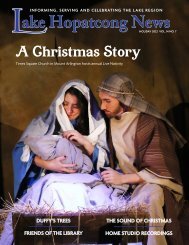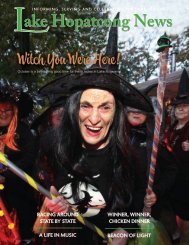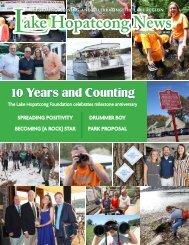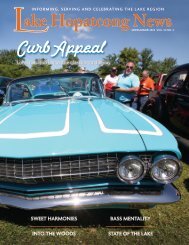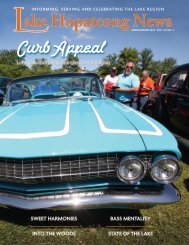Create successful ePaper yourself
Turn your PDF publications into a flip-book with our unique Google optimized e-Paper software.
Jefferson’s Plan for Its ‘Green Assets’ Takes Shape<br />
12<br />
Story by MICHAEL DAIGLE<br />
Photos by Karen Fucito<br />
At 43 square miles, Jefferson Township<br />
is home to miles of frontage on Lake<br />
Hopatcong, deep, winding river valleys and<br />
forested lands.<br />
It is a landscape that brought early settlers to<br />
the township to live and farm. It also offered<br />
the opportunity for industry, which left behind<br />
a community that took roots in the rocky soil.<br />
The early activity also left behind trails,<br />
dirt roads and abandoned railroad beds that<br />
today draw hikers, cyclists and day trippers to<br />
the township to marvel at hilltop vistas, seek<br />
picture-perfect views and conquer challenging<br />
terrain.<br />
But it is a landscape that has left the township<br />
with few places to expand its economic base,<br />
thanks to state law that put a premium on<br />
preserving open space.<br />
The response from the township is to use its<br />
“green assets” to develop additional economic<br />
activity.<br />
“It’s ecotourism,” said Mayor Eric Wilsusen.<br />
Beginning last year, the township offered<br />
support through a resolution for the Lake<br />
Hopatcong Regional Trails Plan that would—<br />
over time—develop a lake-encircling network<br />
of trails for walking, hiking and cycling.<br />
For Jefferson, the idea for this trail system<br />
began in 2001 after the Highlands Act became law<br />
and placed all of Jefferson in the environmentally<br />
sensitive protection zone, which severely limited<br />
development.<br />
LAKE HOPATCONG NEWS <strong>Memorial</strong> <strong>Day</strong> <strong>2023</strong><br />
An open space master plan developed in 2001<br />
called for preservation as a way to protect the<br />
township’s threatened environment.<br />
By 2021, those preserved lands had become<br />
the “green assets” that could be used to boost<br />
the township’s business community as part of<br />
the lake-wide trails plan.<br />
The plan was kick-started in 2021 by a $1<br />
million donation from lake-area businessman<br />
Bela Szigethy. (Lake Hopatcong News is owned<br />
by Szigethy.)<br />
“Jefferson Township and Morris County have<br />
long been interested in building out trails in this<br />
area,” said Szigethy. “There’s a lot of land with<br />
many existing dirt roads and trails. In the long<br />
run, they can be tied in with the existing trail<br />
systems in Mahlon Dickerson and beyond, like<br />
up to Sparta and even down towards Wharton<br />
and Dover. And, of course, into Lake Hopatcong.”<br />
A trails plan was put together by consultant<br />
Pinto Consulting, which is owned by Frank Pinto,<br />
a former Morris County planning director.<br />
The plan will be outlined at 8:30 a.m. on June<br />
3 on National Trails <strong>Day</strong> at Our Lady Star of the<br />
Sea Church on Espanong Road, Jefferson.<br />
Russ Felter, manager of park projects for<br />
the Morris County Park Commission, said the<br />
public information session will include a brief<br />
discussion of the plan, the showing of maps and<br />
other information and a walk to the lake along<br />
one of the neighborhood trails.<br />
Briefly, the plan calls for creating a network of<br />
trails, mostly on public land, that would connect<br />
local neighborhood trails—that sometimes<br />
use roadways and sidewalks—to one another,<br />
and then to a regional trail system that already<br />
crosses the lake region.<br />
According to the plan, the trails would also<br />
connect with business areas, points of interest<br />
and public facilities.<br />
Over time, the plan calls for the development<br />
of 24.5 miles of new trails, at an estimated cost<br />
of $5 million.<br />
According to the report: “This is a major<br />
investment of public and/or private funds<br />
that would need to be carefully planned.” It is<br />
possible that up to 80 percent of the cost is<br />
potentially reimbursable<br />
from existing competitive<br />
trail grant programs, the<br />
report stated.<br />
The proposal comes at<br />
a time when nationwide<br />
trail use has increased.<br />
The data collection<br />
website, Jersey Island<br />
Holidays, reported that<br />
in 2018, there were 47.86<br />
million hikers in the<br />
United States. According<br />
to the site, in <strong>2023</strong>, there<br />
are 57.8 million.<br />
Bob Canace, president of Conservation<br />
Advising Services, who is consulting on the Lake<br />
Hopatcong trail, said trail use that rose during<br />
the pandemic remained high after the pandemic<br />
passed.<br />
Besides using the 12,000 acres of public lands<br />
owned by Jefferson, the proposed trails would<br />
connect with others in Morris County: Mahlon<br />
Dickerson Reservation, with 2,800 acres; the<br />
Berkshire Valley and Rockaway River Wildlife<br />
Management Areas, which are state-operated<br />
and total 5,600 acres; Minnisink Park at 297 acres;<br />
and the Mount Paul section of the 5,656-acre<br />
Kittatinny Valley State Park.<br />
The system would also connect with<br />
the regional Highlands Trail that runs from<br />
Pennsylvania to Connecticut and the local Lake<br />
Hopatcong Trail that runs along the western<br />
shore of the lake.<br />
Bringing the plan to fruition will require<br />
cooperation from Jefferson and Mount<br />
Arlington, Morris County and state Division of<br />
Parks and Forestry (which runs parks and trails)<br />
and the Division of Fish, Game and Wildlife<br />
(which operates the wildlife management areas<br />
with fees from hunting licenses). As such, in<br />
the wildlife management areas, the plan noted<br />
accommodation for hunters and trail uses would<br />
need to be addressed.<br />
The plan envisions a hiker being able to trek<br />
from the Mount Arlington train station to<br />
Kittatinny Valley State Park on a continuous trail,<br />
roughly 18 miles (about a five-hour hike).<br />
With connections into business areas, the plan<br />
offers a potential for economic growth, which<br />
numerous national studies list as a key ingredient<br />
in the development of extensive trail systems.<br />
A 2012 study of the Delaware and Lackawanna<br />
trails in eastern Pennsylvania determined an<br />
average day hiker spent $33.49 during a visit,<br />
while an overnight visitor spent $132 per day and<br />
stayed 2.2 days.<br />
Supporting the trails would be a unified<br />
system of logos and branding materials, including<br />
QR codes linking to services and businesses.<br />
Businesses could, for example, display decals<br />
featuring the trail logo in their front windows.<br />
Wilsusen, Pinto, Felter and Canace, along with<br />
Jesse Merbler and Peter Dolan, both of the New<br />
York-New Jersey Trail Conference, discussed<br />
details of the plan at a planning meeting on April<br />
7.<br />
Key issues were trail construction and safety,<br />
designing local trails to get hikers off streets,<br />
reducing conflicts between hikers and cyclists<br />
Top to bottom: Russ Felter uses ribbon to mark<br />
a new trail in the woods along Castle Rock<br />
Road. Frank Pinto, Bob Canace, Jesse Merbler<br />
and Peter Dolan look at maps during a recent<br />
trail planning meeting.



